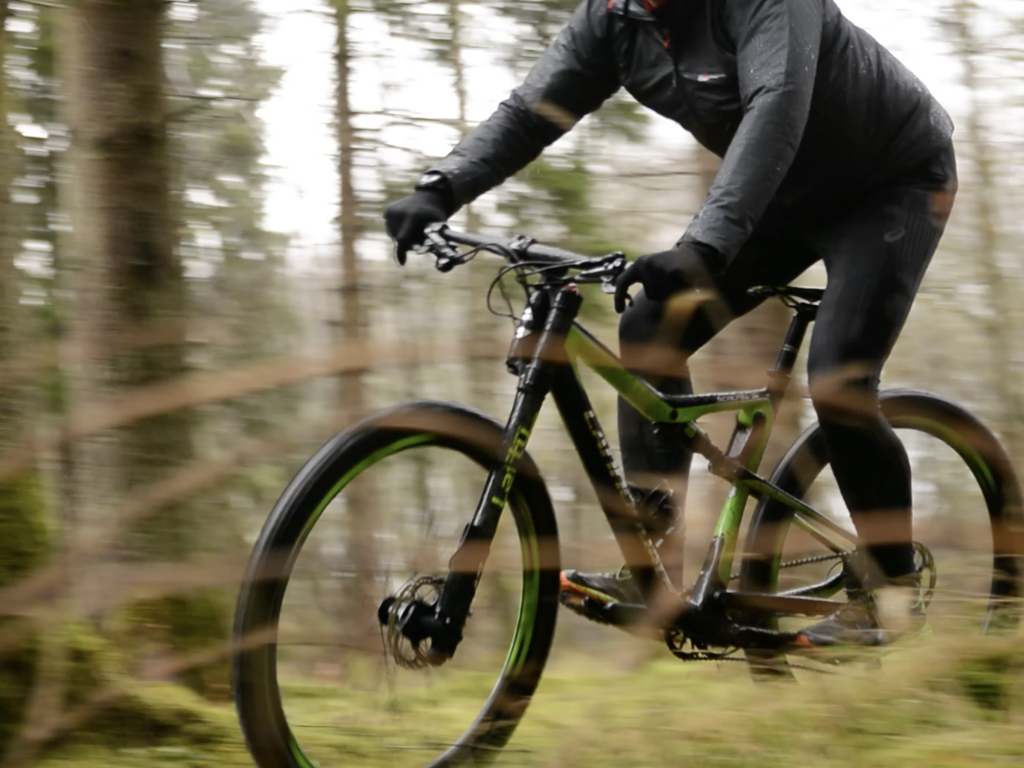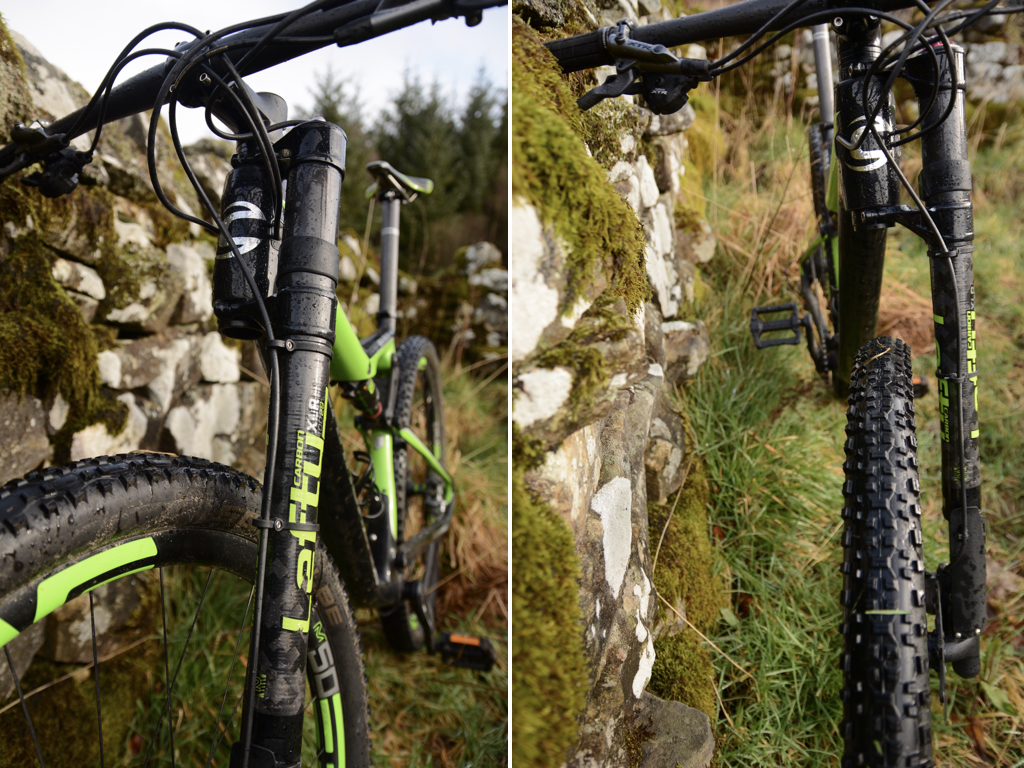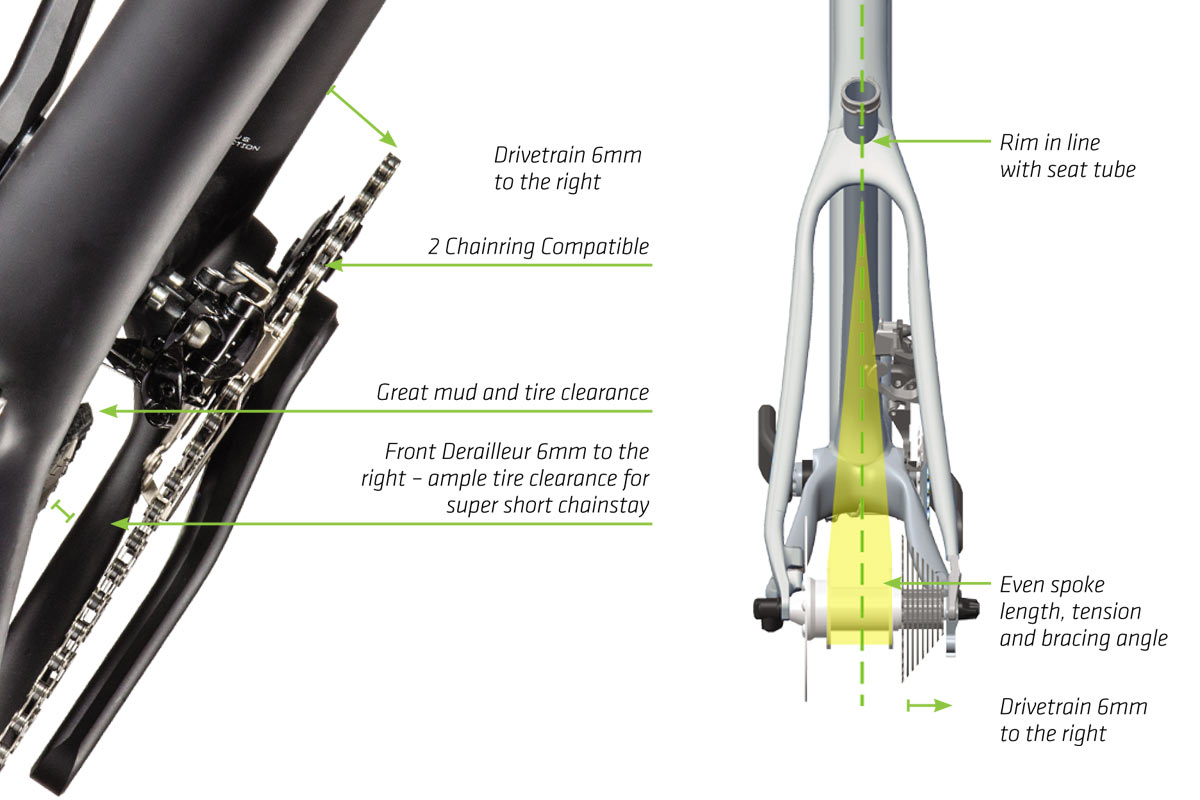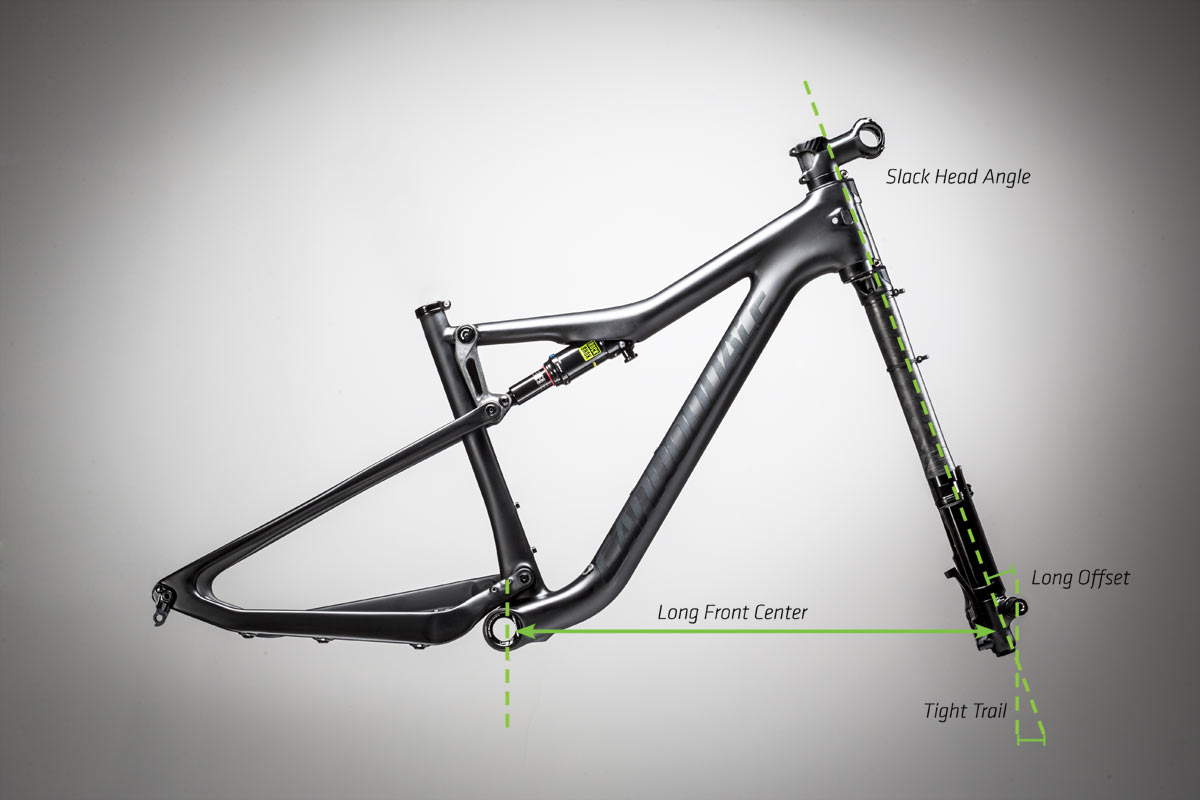The first time we saw the Cannondale Scalpel-Si was last years’ Bikemotion trade fair in Utrecht, the Netherlands. We were impressed by what seemed to be a very technical and complete bike, and couldn’t wait to ride the Scalpel-Si.
 Finally, earlier this year we had a week with the bike and rode it in a variety of circumstances, from wet and slippery in the UK to dry sand pine forests in the Netherlands. We also crashed down some stairs to check how its shocks held up. Normally we would like to spend some more time on a bike, really taking the time to get a feel for it to be able to fully appreciate how it rides and what it does. But in the case of the Cannondale Scalpel-Si it was quite obvious quite quickly. It immediately felt really good, it was light, very fast and handled quite well.
Let’s just look at three really interesting specifications of the bike and what they mean for you as a rider.
Finally, earlier this year we had a week with the bike and rode it in a variety of circumstances, from wet and slippery in the UK to dry sand pine forests in the Netherlands. We also crashed down some stairs to check how its shocks held up. Normally we would like to spend some more time on a bike, really taking the time to get a feel for it to be able to fully appreciate how it rides and what it does. But in the case of the Cannondale Scalpel-Si it was quite obvious quite quickly. It immediately felt really good, it was light, very fast and handled quite well.
Let’s just look at three really interesting specifications of the bike and what they mean for you as a rider.
Conditions
 Finally, earlier this year we had a week with the bike and rode it in a variety of circumstances, from wet and slippery in the UK to dry sand pine forests in the Netherlands. We also crashed down some stairs to check how its shocks held up. Normally we would like to spend some more time on a bike, really taking the time to get a feel for it to be able to fully appreciate how it rides and what it does. But in the case of the Cannondale Scalpel-Si it was quite obvious quite quickly. It immediately felt really good, it was light, very fast and handled quite well.
Let’s just look at three really interesting specifications of the bike and what they mean for you as a rider.
Finally, earlier this year we had a week with the bike and rode it in a variety of circumstances, from wet and slippery in the UK to dry sand pine forests in the Netherlands. We also crashed down some stairs to check how its shocks held up. Normally we would like to spend some more time on a bike, really taking the time to get a feel for it to be able to fully appreciate how it rides and what it does. But in the case of the Cannondale Scalpel-Si it was quite obvious quite quickly. It immediately felt really good, it was light, very fast and handled quite well.
Let’s just look at three really interesting specifications of the bike and what they mean for you as a rider.Lefty
 At BikeMotion we spoke at length to representatives of Cannondale about this very iconic front fork. Cannondale has been producing this fork for more than 17 years, so it has to be more than a marketing gimmick. The big advantage of the lefty or so we were told is the stiffness of the fork and the balance of suspension as the bike travels through corners or during breaking. In a regular fork, the separate legs can travel and twist independently of one another and, through that, can produce disbalance in suspension.
The Lefty has a square inside, the suspension tubes sliding over each other by use of so-called “linear needle bearings” to make sure that during the dampening of impact, the damper only moves up and down and can’t rotate within the fork tube. As a result, the damper is quite rigid. And, having just one leg, the fork is also quite light.
So, that should mean sharp and direct steering, not unlike cutting the trail with a scalpel. And we have to conclude the Scalpel does deliver on its promise. It’s almost counter-intuitive, what with the fork being extremely asymmetrical, but the steering is just as direct, well balanced, and so sharp its really amazing. The only way you notice the lefty is when you pull too hard on your bars when trying a wheelie (just bad technique that is); then the bike will always veer off to the left.
At BikeMotion we spoke at length to representatives of Cannondale about this very iconic front fork. Cannondale has been producing this fork for more than 17 years, so it has to be more than a marketing gimmick. The big advantage of the lefty or so we were told is the stiffness of the fork and the balance of suspension as the bike travels through corners or during breaking. In a regular fork, the separate legs can travel and twist independently of one another and, through that, can produce disbalance in suspension.
The Lefty has a square inside, the suspension tubes sliding over each other by use of so-called “linear needle bearings” to make sure that during the dampening of impact, the damper only moves up and down and can’t rotate within the fork tube. As a result, the damper is quite rigid. And, having just one leg, the fork is also quite light.
So, that should mean sharp and direct steering, not unlike cutting the trail with a scalpel. And we have to conclude the Scalpel does deliver on its promise. It’s almost counter-intuitive, what with the fork being extremely asymmetrical, but the steering is just as direct, well balanced, and so sharp its really amazing. The only way you notice the lefty is when you pull too hard on your bars when trying a wheelie (just bad technique that is); then the bike will always veer off to the left.Asymmetric Integration
 Not as “in your face” as the front fork, but the back fork is also asymmetrical. The drive train has been placed 6mm towards the outside to give room to place the back wheel deeper (27” or 29”) into the frame. That means a shorter chainstay and consequently a bike that is nimble and will turn on a dime. The placement of the wheel deeper into the frame is a big deal. On the one hand, you want your hips to be as close as possible to be directly over the crank, you can just transfer more energy into the pedals in that position. On the other hand, you need your weight above the back wheel as well, to keep pressure on the back wheel for grip on the trail (certainly when climbing.) So with this Asymmetric Integration, you improve the power of the bike, and control over it as well.
Not as “in your face” as the front fork, but the back fork is also asymmetrical. The drive train has been placed 6mm towards the outside to give room to place the back wheel deeper (27” or 29”) into the frame. That means a shorter chainstay and consequently a bike that is nimble and will turn on a dime. The placement of the wheel deeper into the frame is a big deal. On the one hand, you want your hips to be as close as possible to be directly over the crank, you can just transfer more energy into the pedals in that position. On the other hand, you need your weight above the back wheel as well, to keep pressure on the back wheel for grip on the trail (certainly when climbing.) So with this Asymmetric Integration, you improve the power of the bike, and control over it as well.55 mm offset
 So doesn’t a shorter chain stay mean a shorter wheelbase and that the bike could feel more cramped? You don’t want your riding position to be too upright; in descents, you don’t want the feeling that you’re going to be launched over your handlebars with the going gets rough. Enter two things, a slacker head tube angle and the 55 mm offset on the front axle. The head tube angle is 69,5 degrees, and, the front wheel axle is placed 55 mm in front of the fork resulting in the front fork is not too steep and a longer “Front Center” distance. Also resulting in a more generous wheelbase. Equals more stability at higher speeds. In effect, the wheel is further out in front of the rider. What the 55 mm offset also enables is a tighter “trail”.
So doesn’t a shorter chain stay mean a shorter wheelbase and that the bike could feel more cramped? You don’t want your riding position to be too upright; in descents, you don’t want the feeling that you’re going to be launched over your handlebars with the going gets rough. Enter two things, a slacker head tube angle and the 55 mm offset on the front axle. The head tube angle is 69,5 degrees, and, the front wheel axle is placed 55 mm in front of the fork resulting in the front fork is not too steep and a longer “Front Center” distance. Also resulting in a more generous wheelbase. Equals more stability at higher speeds. In effect, the wheel is further out in front of the rider. What the 55 mm offset also enables is a tighter “trail”.
Trail
It is a very subtle measurement and one you have to wrap your head around. ‘Trail is the distance between where the head angle line, and a line drawn vertically down from the axle, meet the ground, and it is a key driver of the self-centering effect of bicycle steering. The bigger the trail measurements, the greater the self-centering effect and the slower the bicycle will steer.’ The shorter the trail the better the bike is at steering.So, what Cannondale has aimed at is a bike that is stable and has agile handling at higher and at lower speeds. In other words, balanced and easy to steer while climbing, or doing technical descents and stable and calm during higher paced segments of the trail. And as far as we are concerned the Scalpel-Si hits the mark. What did we feel?
- A very natural comfortable position, ideal for XC. A flatter back, great fit. Having said that, I am a big lover of dropper posts, just being able to adjust the height of your saddle as you ride helps so much in adjusting to the demands of the terrain that I really missed one on this bike.
- The transfer of power to the wheels is amazing. The bike accelerates so fast.
- The carbon frame is extremely light, so that adds to the ease of bringing the bike up to speed, and keeping it there with the 29” inch wheels is a breeze as well.
- The steering is, indeed very tight, very direct, very nimble. Just lovely. Riding switchbacks on steeper ascents have never been easier.
- Even in very wet circumstances, the bike kept gripping, though we have to admit we didn’t hit really high speeds on the trails we rode.
- We only did a few segments that challenged the suspension and you do notice it “only” has 100mm of travel. It doesn’t dampen and soften higher impacts and if you take rockier descents at high speed it will chatter. But then again, it is not meant as a downhill or heavier duty all-mountain or enduro bike.
- The bike is very nimble and very well balanced; playing around with it on the street, trying some bunny hops, wheelies, track stands and endo’s; it’s playful, easy to get into the air. It just doesn’t feel like a big 29-er.
JTNDYmxvY2txdW90ZSUyMGNsYXNzJTNEJTIyaW5zdGFncmFtLW1lZGlhJTIyJTIwZGF0YS1pbnN0Z3JtLWNhcHRpb25lZCUyMGRhdGEtaW5zdGdybS12ZXJzaW9uJTNEJTIyNyUyMiUyMHN0eWxlJTNEJTIyJTIwYmFja2dyb3VuZCUzQSUyM0ZGRiUzQiUyMGJvcmRlciUzQTAlM0IlMjBib3JkZXItcmFkaXVzJTNBM3B4JTNCJTIwYm94LXNoYWRvdyUzQTAlMjAwJTIwMXB4JTIwMCUyMHJnYmElMjgwJTJDMCUyQzAlMkMwLjUlMjklMkMwJTIwMXB4JTIwMTBweCUyMDAlMjByZ2JhJTI4MCUyQzAlMkMwJTJDMC4xNSUyOSUzQiUyMG1hcmdpbiUzQSUyMDFweCUzQiUyMG1heC13aWR0aCUzQTY1OHB4JTNCJTIwcGFkZGluZyUzQTAlM0IlMjB3aWR0aCUzQTk5LjM3NSUyNSUzQiUyMHdpZHRoJTNBLXdlYmtpdC1jYWxjJTI4MTAwJTI1JTIwLSUyMDJweCUyOSUzQiUyMHdpZHRoJTNBY2FsYyUyODEwMCUyNSUyMC0lMjAycHglMjklM0IlMjIlM0UlM0NkaXYlMjBzdHlsZSUzRCUyMnBhZGRpbmclM0E4cHglM0IlMjIlM0UlMjAlM0NkaXYlMjBzdHlsZSUzRCUyMiUyMGJhY2tncm91bmQlM0ElMjNGOEY4RjglM0IlMjBsaW5lLWhlaWdodCUzQTAlM0IlMjBtYXJnaW4tdG9wJTNBNDBweCUzQiUyMHBhZGRpbmclM0E1MC4wJTI1JTIwMCUzQiUyMHRleHQtYWxpZ24lM0FjZW50ZXIlM0IlMjB3aWR0aCUzQTEwMCUyNSUzQiUyMiUzRSUyMCUzQ2RpdiUyMHN0eWxlJTNEJTIyJTIwYmFja2dyb3VuZCUzQXVybCUyOGRhdGElM0FpbWFnZSUyRnBuZyUzQmJhc2U2NCUyQ2lWQk9SdzBLR2dvQUFBQU5TVWhFVWdBQUFDd0FBQUFzQ0FNQUFBQXBXcW96QUFBQUJHZEJUVUVBQUxHUEMlMkZ4aEJRQUFBQUZ6VWtkQ0FLN09IT2tBQUFBTVVFeFVSY3pNelBmMzk5ZlgxJTJCYm01bXpZOUFNQUFBRGlTVVJCVkRqTHZaWGJFc01nQ0VTNSUyRlA4JTJGdDlGdVJWQ1JtVTczSldsem9zZ1NJSVpVUkNqbyUyRmFkJTJCRVFKSkI0SHY4QkZ0JTJCSURwUW9DeDF3ak9TQkZoaDJYc3N4RUlZbjN1bEklMkY2TU5SZUUwN1VJV0pFdjhVRU9XRFM4OExZOTdrcXlUbGlKS0t0dVlCYnJ1QXlWaDV3T0hpWG1waTV3ZTU4RWswMjhjend5dVFkTEtQRzFCa2I0Tm5NJTJCVmVBbmZIcW4xazQlMkJHUFQ2dUdRY3Z1MmgyT1Z1SWYlMkZnV1VGeXk4T1dFcGR5WlNhM2FWQ3FwVm9WdnpaWjJWVG5uMndVOHF6VmpERGV0TzkwR1N5OW1WTHF0Z1lTeTIzMU14clk2STJnR3FqclRZMEw4ZnhDeGZDQmJoV3JzWVlBQUFBQUVsRlRrU3VRbUNDJTI5JTNCJTIwZGlzcGxheSUzQWJsb2NrJTNCJTIwaGVpZ2h0JTNBNDRweCUzQiUyMG1hcmdpbiUzQTAlMjBhdXRvJTIwLTQ0cHglM0IlMjBwb3NpdGlvbiUzQXJlbGF0aXZlJTNCJTIwdG9wJTNBLTIycHglM0IlMjB3aWR0aCUzQTQ0cHglM0IlMjIlM0UlM0MlMkZkaXYlM0UlM0MlMkZkaXYlM0UlMjAlM0NwJTIwc3R5bGUlM0QlMjIlMjBtYXJnaW4lM0E4cHglMjAwJTIwMCUyMDAlM0IlMjBwYWRkaW5nJTNBMCUyMDRweCUzQiUyMiUzRSUyMCUzQ2ElMjBocmVmJTNEJTIyaHR0cHMlM0ElMkYlMkZ3d3cuaW5zdGFncmFtLmNvbSUyRnAlMkZCUTA0LU9IQVZMdSUyRiUyMiUyMHN0eWxlJTNEJTIyJTIwY29sb3IlM0ElMjMwMDAlM0IlMjBmb250LWZhbWlseSUzQUFyaWFsJTJDc2Fucy1zZXJpZiUzQiUyMGZvbnQtc2l6ZSUzQTE0cHglM0IlMjBmb250LXN0eWxlJTNBbm9ybWFsJTNCJTIwZm9udC13ZWlnaHQlM0Fub3JtYWwlM0IlMjBsaW5lLWhlaWdodCUzQTE3cHglM0IlMjB0ZXh0LWRlY29yYXRpb24lM0Fub25lJTNCJTIwd29yZC13cmFwJTNBYnJlYWstd29yZCUzQiUyMiUyMHRhcmdldCUzRCUyMl9ibGFuayUyMiUzRVllc3RlcmRheSUyMHdlJTIwcmVjZWl2ZWQlMjB0aGUlMjBTY2FscGVsLVNpJTIwUmFjZSUyMGZyb20lMjAlNDBjYW5ub25kYWxlbmwlMjBmb3IlMjBvdXIlMjB1cGNvbW1pbmclMjB0cmlwJTIwdG8lMjBFbmdlbGFuZC4lMjBDb3VsZG4lMjYlMjMzOSUzQnQlMjB3YWl0JTIwdG8lMjByaWRlJTIwaXQlMjBzbyUyMGRpZCUyMHNvbWUlMjB1cmJhbiUyMHJpZGluZy4lMjBGcmlkYXklMjBoaXR0aW5nJTIwdGhlJTIwdHJhaWxzJTIwb2YlMjBLaWVsZGVyJTIwRm9yZXN0LiU0MGNhbm5vbmRhbGViaWtlcyUyMCUyM210YiUyMCUyM21vdW50YWluYmlrZSUyMCUyM21vdW50YWluYmlrZW4lMjAlMjN1cmJhbiUyMCUyM3VyYmFucmlkZSUyMCUyM2dyYWZmaXRpJTIwJTIzYXJuaGVtJTIwJTIzY2Fubm9uZGFsZSUyMCUyM2Nhbm5vbmRhbGViaWtlcyUyMCUyM2Nhbm5vbmRhbGVzY2FscGVsJTNDJTJGYSUzRSUzQyUyRnAlM0UlMjAlM0NwJTIwc3R5bGUlM0QlMjIlMjBjb2xvciUzQSUyM2M5YzhjZCUzQiUyMGZvbnQtZmFtaWx5JTNBQXJpYWwlMkNzYW5zLXNlcmlmJTNCJTIwZm9udC1zaXplJTNBMTRweCUzQiUyMGxpbmUtaGVpZ2h0JTNBMTdweCUzQiUyMG1hcmdpbi1ib3R0b20lM0EwJTNCJTIwbWFyZ2luLXRvcCUzQThweCUzQiUyMG92ZXJmbG93JTNBaGlkZGVuJTNCJTIwcGFkZGluZyUzQThweCUyMDAlMjA3cHglM0IlMjB0ZXh0LWFsaWduJTNBY2VudGVyJTNCJTIwdGV4dC1vdmVyZmxvdyUzQWVsbGlwc2lzJTNCJTIwd2hpdGUtc3BhY2UlM0Fub3dyYXAlM0IlMjIlM0VFZW4lMjBiZXJpY2h0JTIwZ2VkZWVsZCUyMGRvb3IlMjBHZWFyTGltaXRzJTIwJTI4JTQwZ2VhcmxpbWl0cyUyOSUyMG9wJTIwJTNDdGltZSUyMHN0eWxlJTNEJTIyJTIwZm9udC1mYW1pbHklM0FBcmlhbCUyQ3NhbnMtc2VyaWYlM0IlMjBmb250LXNpemUlM0ExNHB4JTNCJTIwbGluZS1oZWlnaHQlM0ExN3B4JTNCJTIyJTIwZGF0ZXRpbWUlM0QlMjIyMDE3LTAyLTIyVDE5JTNBNTYlM0E1MyUyQjAwJTNBMDAlMjIlM0UyMiUyMEZlYiUyMDIwMTclMjBvbSUyMDExJTNBNTYlMjBQU1QlM0MlMkZ0aW1lJTNFJTNDJTJGcCUzRSUzQyUyRmRpdiUzRSUzQyUyRmJsb2NrcXVvdGUlM0UlMEElM0NzY3JpcHQlMjBhc3luYyUyMGRlZmVyJTIwc3JjJTNEJTIyJTJGJTJGcGxhdGZvcm0uaW5zdGFncmFtLmNvbSUyRmVuX1VTJTJGZW1iZWRzLmpzJTIyJTNFJTNDJTJGc2NyaXB0JTNF
And that’s because it isn’t. Cannondale has built a very complete XC bike (except for the dropper post we missed), it’s hard to get a better one I would guess. Given that the bike sells for a whopping € 8500,- euro’s, you would expect nothing less. We didn’t even take the time to take a look at all the high-end components, such as the Shimano XTR shifters, brake levers, brakes and back derailleurs. This is a bike that makes us stand back in awe. It’s so well thought out, the components, geometry are so well integrated. Just wow.










